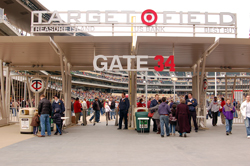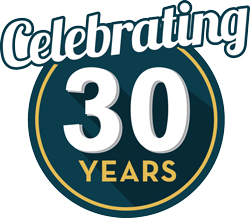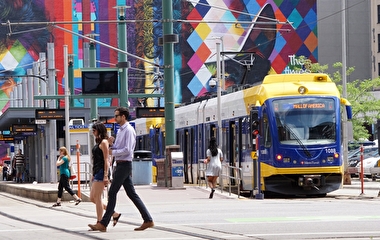For several generations, transportation policymakers and practitioners have favored a “mobility” approach, aimed at moving people and vehicles as fast as possible by reducing congestion. However, the limits of this approach have become more apparent over time, as residents struggle to reach workplaces, schools, hospitals, shopping, and numerous other destinations in an equitable and sustainable manner.
Researchers have been able to define this challenge more precisely and elevate the importance of “accessibility” over the past few decades, but the adoption of new policies, tools, and investments by practitioners remains slow and uneven across most regions. During CTS’s 2017 Spring Luncheon presentation, Brookings Institution fellow Adie Tomer offered highlights from the institution’s Moving to Access Initiative, which visualizes challenges of the current mobility model, impediments to adopting an accessibility-focused approach, and a vision for where metro areas can go from here.
“Every time there are big infrastructure initiatives, the conversation goes to what we are building,” said Tomer.
“It’s easy to lose sight of the fact that infrastructure is about people—about making sure they can get to the activities they want and need to do in order to find opportunity, success, and happiness.”
Urban development trends in recent decades have heightened the need for accessibility and presented new barriers to accessibility as cities expand outward rapidly. “Because of this rapid expansion, the current method we are using to get people around is cars,” Tomer said. “Travel in the auto era is on a different scale, and as a result there is often a spatial mismatch between where people live and work. The costs for household transportation and transportation infrastructure have become tremendous, and pollution from the transportation sector has become a major issue.”
making sure they can get to activities
they need and want to do.
To address these problems, Tomer advocates building around accessibility. “This allows us to orient our thinking to access to a destination, and transportation becomes the means to an end and not an end unto itself,” Tomer said.“There are three main components to this approach: the transportation system itself, urban planning and land use, and finances.”
Though the case for moving to an accessibility model is strong, many challenges remain. “First, you have legacy issues—you can’t easily tear down what is already built, so we need to figure out how to work with the bones we already have,” Tomer said. “In addition, there are issues around who will pay for the infrastructure and operation of our transportation systems, the governance challenges of moving away from our siloed approach to governing, and the lack of definition, measurement, and standardization around the concept of accessibility.”






